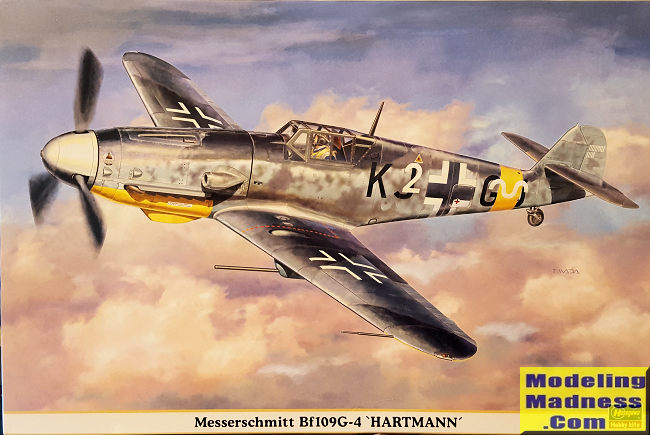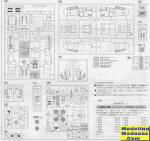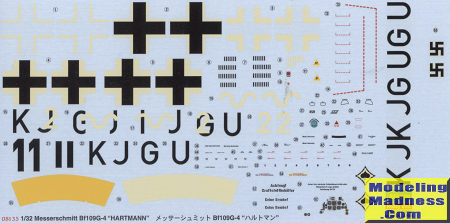
Hasegawa 1/32 Bf-109G-4
| KIT #: | 08135 |
| PRICE: | 4300 yen SRP |
| DECALS: | Two options |
| REVIEWER: | Scott Van Aken |
| NOTES: | 2002 release. |

| HISTORY |
In September 1942, the Bf-109G-4 appeared; this version was identical to the G-2 in all aspects, including performance, except for being fitted with the FuG 16 VHF radio set, which provided much clearer radio transmissions and had three-times the range of the earlier HF sets. Externally this could be recognised by the position of the fuselage antenna lead-in which was moved further aft to between frames seven and eight on the fuselage spine. Due to the steady weight increases of the 109, from the spring of 1943 larger 660 × 160 mm (26 × 6.3 in) mainwheels were introduced, replacing the previously used 650 × 150 mm (25.6 × 6 in) type. The undercarriage legs were altered so that the wheel's vertical axis was nearly upright rather than being parallel with the oleo leg. These changes resulted in the fitting of teardrop-shaped fairings to the upper wing surface above the wheel-wells to accommodate the upper part of the mainwheels. The larger wheels and fairings were often retrofitted to G-2s. In addition, a larger 350 × 135 mm (14 × 5 in) tailwheel replaced the original 290 × 110 mm (11 × 4 in) one; the larger tailwheel no longer fitted the recess, so the retraction mechanism was disconnected and the tailwheel fixed down. Up to July 1943, 1,242 G-4s were produced, with an additional four in Győr and WNF factories in the second half of 1943. Between January and February 1943, 50 examples of a pressurized version, the G-3 were also produced; similar to the G-1 although it was equipped with the same FuG 16 VHF radio set as the G-4.
| THE KIT |
 If
you have seen the earlier Bf-109G-6 kit, then this one will be somewhat familiar
as it uses most of the same sprues (wings, landing gear, and such. However,
the kit does not include all the bits needed for a G-6 so you are pretty well
limited to doing a G-4 or possibly a G-2 as they are, as the intro states,
pretty much identical.
If
you have seen the earlier Bf-109G-6 kit, then this one will be somewhat familiar
as it uses most of the same sprues (wings, landing gear, and such. However,
the kit does not include all the bits needed for a G-6 so you are pretty well
limited to doing a G-4 or possibly a G-2 as they are, as the intro states,
pretty much identical.
Starting with the cockpit, you get a fair amount of detail, but an aftermarket set would very much spruce it up. A pilot figure is provided for those who want one. If not using it, you really should get an aftermarket harness. Hasegawa provides decals and they do fit well atop the raised instrument detail.
The fuselage has a separate, early style tail section. Many modelers will glue each tail half to the fuselage first to eliminate any possible seam issues. There is detail that fits on the sidewall and once the fuselage halves are joined, the interior slips in from the underside. With the cockpit in a center section with wing spars is attached.
With the wings, holes must be opened to accept the wheel bulges. I'm not sure if the early G-4s, one of which is the box art plane, had these as they did not have the later wheels. Check photos. If using the underwing cannon, and both options have them, open the holes in the lower wing. The wings then pretty much just slide in place.
One then attaches the forward and upper colwing along with the exhaust and supercharger intake. One option uses the sand filter. Landing gear and wheels are then built up. Hasegawa has provided resin wheels for the early version. The rest of the kit is pretty much just attaching things like oil cooler assembly, canons, tail planes, drop tank, flaps, prop and canopy. This latter item can be posed open or closed.
 Instructions are quite good with the usual Gunze paint
references. The two markings options are nearly identical with one being the box
art plane in RLM 74/75/76 with a yellow lower engine cowling, lower wing tips,
and fuselage band. This was an aircraft put into service without removing the
radio call numbers. Hasegawa offers these in once piece or separately. The
second is is a JG 53 aircraft in the desert camouflage scheme of RLM 78/79. It
has a yellow lower cowling, white lower wing tips, spinner and fuselage band.
The decals are quite complete and old school where the whites are off-white.
Instructions are quite good with the usual Gunze paint
references. The two markings options are nearly identical with one being the box
art plane in RLM 74/75/76 with a yellow lower engine cowling, lower wing tips,
and fuselage band. This was an aircraft put into service without removing the
radio call numbers. Hasegawa offers these in once piece or separately. The
second is is a JG 53 aircraft in the desert camouflage scheme of RLM 78/79. It
has a yellow lower cowling, white lower wing tips, spinner and fuselage band.
The decals are quite complete and old school where the whites are off-white.
| CONCLUSIONS |
For several years, Hasegawa had the 1/32 Bf-109 market pretty well covered. Recently Trumpeter has done a series of these planes, but I've not seen one so cannot comment on it. Revell has done a G-6 and G-10. While they are very nice and less expensive, they are also more detailed and are more parts intensive. The Hasegawa kits are very straight-forward builds and turn out just great straight from the box.
| REFERENCES |
https://en.wikipedia.org/wiki/Messerschmitt_Bf_109_variants#G-3,_G-4
November 2020 Copyright ModelingMadness.com.
All rights reserved. If you would like your product reviewed fairly and
fairly quickly, please
contact
the editor
or see other details in the
Note to
Contributors.
Back to the Main Page
Back to the Review
Index Page
Back to the Previews Index Page